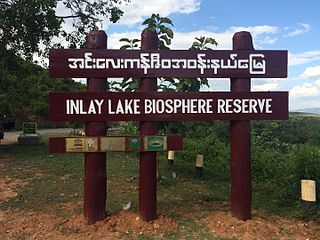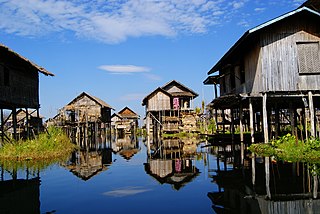
Water garden or aquatic garden, is a term sometimes used for gardens, or parts of gardens, where any type of water feature is a principal or dominant element. The primary focus is on plants, but they will sometimes also house waterfowl, or ornamental fish, in which case it may be called a fish pond. They vary enormously in size and style.

A floating island is a mass of floating aquatic plants, mud, and peat ranging in thickness from several centimeters to a few meters. Sometimes referred to as tussocks, floatons, or suds, floating islands are found in many parts of the world. They exist less commonly as an artificial island. Floating islands are generally found on marshlands, lakes, and similar wetland locations, and can be many hectares in size.

Dal is a freshwater lake in Srinagar, the summer capital of Jammu and Kashmir in Indian-administered Kashmir. It is an urban lake, the second largest lake in Jammu and Kashmir, and the most visited place in Srinagar by tourists and locals. It is integral to tourism and recreation in the Kashmir valley and is variously known as the "Lake of Flowers", "Jewel in the crown of Kashmir" or "Srinagar's Jewel". The lake is also an important source for commercial operations in fishing and water plant harvesting.

Taunggyi (Burmese: တောင်ကြီးမြို့; MLCTS: taung kri: mrui. ; Shan: ဝဵင်းတူၼ်ႈတီး ဝဵင်းလူင်တႆးႁဝ်း Shan pronunciation:[weŋ˥ton˧˧˨ti˥]; Pa'O language : ဝေင်ꩻတောင်ႏကီꩻ is the capital and largest city of Shan State, Myanmar ဝဵင်းလူင်မိူင်းတႆး and lies on the Thazi-Kyaingtong road at an elevation of 4,712 feet, just north of Shwenyaung and Inle Lake within the Myelat region. Taunggyi is the fifth largest city of Myanmar, although Taunggyi is the capital of Shan State, 45% of Population are Pa'O people and has an estimated population of 380,665 as of 2014. The city is famous for its hot air balloon festival held annually on the full moon day of Tazaungmon.

Devario auropurpureus is a small species of danionin fish endemic to Lake Inle in Myanmar. It is a schooling species associated with submerged vegetation. It is harvested for aquarium trade, and usually sold under the older name Inlecypris auropurpurea. This species has also been found for sale under the common name "Lake Inle Trout Danio" in some tropical fish retailers.
Baiyang Lake, also known as Lake Baiyangdian, is located in the Xiong'an New Area of Baoding, a prefecture-level city in Hebei Province, China. It is the largest freshwater lake in northern China. It is referred to as the Kidney of North China.

Yawnghwe, known as Nyaungshwe in Burmese, was a Shan state in what is today Myanmar. It was one of the most important of the Southern Shan States. Yawnghwe state included the Inle Lake. The administrative capital was Taunggyi, located in the northern part of the state. The Agent of the British government, the Superintendent of the Southern Shan States, resided at Taunggyi and the king's palace was at Yawnghwe.

The Intha are members of a Tibeto-Burman ethnic group living around Inle Lake. There are around 100,000 to 200,000 Intha.

Phaung Daw U Pagoda, also spelt Phaung Daw Oo or Hpaung Daw Oo, is a notable Buddhist pagoda in Myanmar, located in the village of Ywama on Inle Lake in Shan State. The pagoda is the site of a major annual pagoda festival during which the temple's principal Buddha images are circulated on a royal barge across Inle Lake.

Nyaungshwe Township is a township of Taunggyi District in Shan State, Myanmar. It is located south of Sakangyi and south-west of Taunggyi. The township contains one town, the principal town of Nyaungshwe and 35 village tracts, comprising 8 urban wards and 445 villages in total.

Pinlaung Township is a township of Taunggyi District in the Shan State of Myanmar. It is one of three townships in the Pa-O Self-Administered Zone. Its principal town is Pinlaung. According to the 2014 Myanmar Population and Housing Census, there are 115,047 residents in the township.

Inlay Lake Wetland Sanctuary is a protected area in Myanmar's Shan State, covering an area of 533.73 km2 (206.07 sq mi) surrounding Inle Lake. It ranges in elevation from 830 to 1,270 m, stretching over Nyaungshwe, Pinlaung and Pekon Townships. It was gazetted in 1985 to protect habitats for migratory birds. In 2003, it was designated as one of the ASEAN Heritage Parks, and in 2015 as the first Biosphere Reserve in the country.

Ywama village, also known as Heya Ywama, is located on the western side of Inle Lake in Nyaungshwe Township, Taunggyi District, Shan State, Myanmar. The village is most easily accessible by boat from the town of Nyaung Shwe on the north side of the lake.
Cyprinus intha is a species of ray-finned fish in the genus Cyprinus. The species is endemic to Inle Lake, a large, isolated freshwater lake on the Shan Plateau in eastern Myanmar. It is considered to be endangered, among other reasons, because of widespread hybridization with introduced Common Carp, Cyprinus carpio.

Htamin jin is a Burmese dish of fermented rice. It is the regional specialty and signature dish of the Intha people of Inle Lake in Shan State, Myanmar.
Intha and Danu are southern Burmish languages of Shan State, Burma, spoken respectively by the Intha and Danu people, the latter of whom are Bamar descendants who migrated to Inle Lake in Shan State. Considered to be dialects of Burmese by the Government of Myanmar, Danu has 93% lexical similarity with standard Burmese, while Intha has 95% lexical similarity with standard Burmese. Intha and Danu differ from standard Burmese with respect to pronunciation of certain phonemes, and few hundred local vocabulary terms. Language contact has led to increasing convergence with standard Burmese. Both are spoken by about 100,000 people each.

Red dwarf rasbora is a species of cyprinid found endemic to Lake Inle in Shan State in Myanmar. It belongs to the genus Microrasbora, which contains two small species of danionins.
Sunye Lake, also known as Sunye In, is a freshwater natural lake located near Kyaukse and Sintgaing, the large inland body of standing water measures approximately 4 square miles (10 km2) and is known as "little Inle".

Lotus silk is a type of textile produced using delicate lotus stem fibers. The fabric first originated in Myanmar (Burma) and is now largely produced in Siem Reap, Cambodia. Some small cottage workshops start experimenting in Vietnam and India as well. Due to the complexity and labor-intensive nature of weaving lotus fibers, lotus silk is considered one of the most expensive fabrics in the world. Lotus silk uses fibres from a specific variety of lotus called padonma kya (ပဒုမ္မာကြာ), which produces large, fragrant pink flowers.
Dailab Lake is located in Banswara, Rajasthan, India, and is known for its serene beauty and year-round bloom of lotus flowers. The lake is surrounded by lush greenery and is a popular spot for picnics and boating. Dailab Lake has cultural significance in Banswara and plays an important role in the local ecology.































